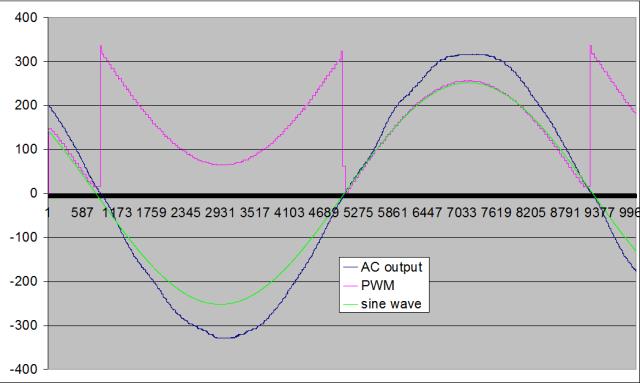Guru
Joined: 02/02/2017
Location: AustraliaPosts: 1432
| Posted: 05:38am 13 Apr 2018 |
Part 19: examining EG8010 pulse width modulation
Today I show what I have found when looking at the measured PWM duty cycle
of an EG8010 based inverter board.
I wanted to look at the shape of the PWM duty cycle during a 50Hz cycle
and maybe see if it differs from a sine wave.
My prototype inverter, driven by an Arduino running custom software used
PWM duty cycles based purely on the value of a sine curve at the required angles.
With a 20Khz PWM base frequency, this leaves 200 individual PWM cycles to modulate.
I was wondering if the EG8010 was doing any special voodoo with the PWM duty cycle or just plain sine function based modulation.
First I obtained a complete 50Hz (plus a bit) output AC waveform as well as the low side 20Khz mosfet gate drive signal. The DSO I have has ample memory for this and I ended up with 3M samples of these 2 channels, plus DC current and primary winding current. The sample rate was 150 M samples /second. This is almost too much data.
A bit of VB.net code gave me a nice .csv file to import into Excel.
I resampled the 150Msamples /sec data down to only 10,000 samples to keep it
reasonable for Excel.
Dark Blue is AC output voltage, It is higher magnitude to allow a clear view of
the other 2 curves. The Excel file lets you tune it so they all line up.
Green is a pure sine wave, aligned with AC output
Purple is calculated PWM duty cycle (i.e. counts of samples of the gate drive when it is > 8V)

So it seems to me the EG8010 is using PWM duty cycle almost exactly the same
as a sine wave.
There you go.
I was always wondering what EG used and now we know.
I was hoping to maybe see some trickery (i.e. modification to sine wave) in the EG8010 PWM that might be the cause of the wobbles in AC output seen immediately after AC output voltage crosses zero. But no. This means the wobbles are electronic of origin and my idea that these wobbles are due to the injection of very high frequency pulses into the primary remains the best explanation.
I attach the excel file if you want a look at it.
2018-04-13_152659_pwm.zip
wronger than a phone book full of wrong phone numbers